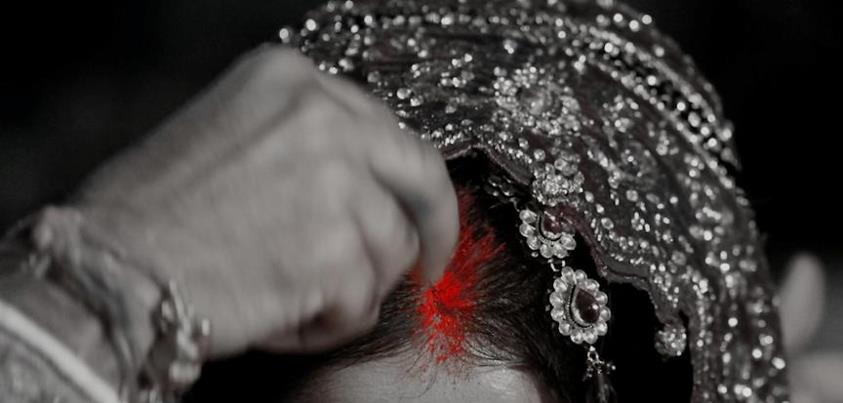Significance of Sindoor in Indian marriage

The significance of Sindoor in Indian marriage goes back to the Vedic century. The custom of wearing Sindoor on the forehead in the parting of hair by married Hindu women is considered auspicious and is being carried on since centuries.
What separates married and unmarried women is the Sindoor that is applied as a red streak on the parting of a woman’s hair. It symbolizes the husband’s long and healthy life.
The first time Sindoor is applied is during the marriage ceremony where the groom recites the slokas and adorns the bride with it. This ceremony is known as Sindoor-Daan and is still carried on in present times.
Scholars say that as per mythology, red is the color of power while vermilion is a symbol of the female energy of Parvati/Sati. As per holy scriptures, Sati is regarded as the ideal wife who sacrificed her life for her husband's honor and every Hindu wife represents Shakti or Sati. While blessing a married woman it is said, “Akhand Saubhagyavati Bhava” which means “May you always be the one whose husband is alive and may you remain safe from the curse of widowhood”. It is said that Goddess Parvati not only protects the husbands of all the married women who wear sindoor but additionally wards off any evil.
What separates married and unmarried women is the Sindoor that is applied as a red streak on the parting of a woman’s hair. It symbolizes the husband’s long and healthy life.
The first time Sindoor is applied is during the marriage ceremony where the groom recites the slokas and adorns the bride with it. This ceremony is known as Sindoor-Daan and is still carried on in present times.
Scholars say that as per mythology, red is the color of power while vermilion is a symbol of the female energy of Parvati/Sati. As per holy scriptures, Sati is regarded as the ideal wife who sacrificed her life for her husband's honor and every Hindu wife represents Shakti or Sati. While blessing a married woman it is said, “Akhand Saubhagyavati Bhava” which means “May you always be the one whose husband is alive and may you remain safe from the curse of widowhood”. It is said that Goddess Parvati not only protects the husbands of all the married women who wear sindoor but additionally wards off any evil.
Sindoor and its astrological significance
According to Hindu astrology, the House of Aries or Mesha Rashi is situated on the forehead. The Lord of Aries is Mars and its color is red which is believed to be auspicious. This is another reason why red sindoor is applied at the forehead and at the hair partition. Also, both are signs of Saubhagya (good luck). Sindoor is likewise considered as the symbol of the female energy of Shakti.
Health significance of Sindoor
The significance of Sindoor pertains to physiological aspects as well. Did you know that Sindoor is prepared by mixing turmeric, lime and the metal Mercury? These ingredients carry numerous benefits on the health that accentuates the benefit of using Sindoor. For instance, the properties of Mercury include controlling blood pressure, reducing stress and activating sexual drive. This is another reason why Sindoor is prohibited for the widows.
Sindoor also helps in keeping the brain active and alert. For best results, Sindoor must be applied right up to the pituitary gland where all our feelings reside.
Interesting facts of Sindoor
- Sindoor is applied not only in the hair-partition (maang) but also as a dot on the forehead as Bindi.
- Sindoor is one of the 16 embellishments (Solah Shringar) as per Hinduism.
- Sindoor is also being applied by the men as “Tilak” on their forehead.
- The color of Indian Sindoor is red which is also known as “Kumkum” when it's mixed with turmeric. It was called “Kasturi” as per ancient Indian scriptures and known as “Vermillion” in English.
Facts about Sindoor
Here are some facts about Sindoor.
- The female figurines of Harappa civilization as per the archeological excavation conducted in Mehrgarh (Baluchistan) shows the use of sindoor in hair partition.
- Parvati, the essence of all women, blesses grace and power on the married ladies who wear vermillion on their parting.
- Sita used to apply sindoor to delight her husband, Lord Rama. Noticing this, Lord Hanuman smeared sindoor all over his body to please Rama. Even today, devotees of Lord Hanuman apply sindoor on God’s idols.
- Draupadi, the wife of Pandavas, wiped off her vermilion in repulsion after the event where Dushashan tried to strip off the saree in the Hastinapur court, as per Mahabharata.
- The lover of Lord Krishna – Radha, turned Kumkum into a flame-like design on her forehead.
- Sindoor is also mentioned in several Puranas, Lalitha Sahasranamam and Adi Shankaracharya's Soundarya Lahiri.
- Sindoor is also offered to Lord Ganesha. The “Sindoor Lal Chadhayo Gajamukha Ko”, popular Ganesh Aarti in the Marathi language says that applying Sindoor to Lord Ganesh will appease the Almighty and remove all obstacles in your way.
- Sindoor is also used to worship Goddesses like Shakti and Lakshmi.
- Sindoor is applied by Shaivites, Vaishnavas and Swaminarayan on their forehead.

Sindoor and Current Scenario
- While Jain women apply sindoor Jain nuns are prohibited from it.
- Did you know that Sufi leader Sharafuddin Maneri encouraged Islamic ladies of Bangladesh to apply sindoor, but this move was met with contempt by reformist movements of 19th century?
- Sindoor is thrown along with other mixtures into the air during popular festival Holi.
Hindu devotees regardless of men and women apply sindoor on their forehead while visiting a temple or attending a religious ritual. At earlier times, women used to make Kumkum at home but now it is easily available in the market.
Scientific Significance of Sindoor
Here are a few scientific reasons behind wearing Sindoor.
Spiritual Progress
In the Hindu religion, married women have been applying sindoor in hair parting since ages. There are logical reasons behind this belief. The parting line of a woman’s hair where sindoor is applied resides the most central spot, the spiritual center called Brahmarandhra, an opening in the crown of the head. This astral aperture is exceptionally sensitive and said to be the doorway to the “absolute” running from the perineum to the crown of the head. This is the place where the partition is made and sindoor is drawn. Also, Sindoor contains Mercury which is the only metal found in liquid form. When you apply sindoor the hair partition, the Mercury present in it works as a medicine to maintain an active brain.
Fighting stress
The custom of ‘Maang baro’ – filling the sindoor in women’s head is conducted during the marriage ceremony. The underlying reason is that the free-spirited girl now shoulders new duties of being a responsible wife and a respectful daughter-in-law. Handling such tasks can lead to pressure. The Mercury in the Sindoor alleviates her stress and gives her mental peace. The therapeutic effects of mercury help a woman to keep her mind calm, composed and poised.

Kindling the Sixth Chakra
Kumkum or Turmeric-based sindoor carries both scientific and spiritual benefits for the ladies. It enhances the power of concentration. The Sixth chakra (third eye or Ajna Chakra) is centered on the forehead between the eyebrows. It’s considered as the channel through which mental power and spirituality can be enhanced.
Enhances the beauty
Sindoor increases the feminine grace to a large extent and gives divine beauty. Red is also known as the color of love and passion and hence applied by Indian women to win the heart of their husbands. Sindoor signifies that the woman is married and is under the protection of her husband and thus no one should cast an evil eye on her. Also, the color of fire, blood and strength, the shade Red indicates that women should never be considered and should be respected as Shakti (goddess of strength). She can be the spark of fire or a soft flower at her own will to protect herself as well as her motherland.
The significance of Sindoor in Indian marriage holds great aspect both in science as well as in the spiritual path. Do you have more insights? Let us know in the comment section below.
We, at Kerala Marriage, strive to help man and woman find their ideal partner. If you are looking to find your soul mate, register today and be a step closer towards a happy and prosperous life.
Post-wedding Marwari wedd...
In this guide, we will talk about Post-wedding Marwari Wedding Rituals. We presume you had already read our Pre-wedding Mar ...
Top 10 tips to avoid frau...
Beware!!! One single mistake will cost you a lifetime. Matrimonial frauds are on the rise, especially in India. Even af ...
Muslim Marriage Act in In...
In this guide, we will take a look at the Muslim Marriage Act in India. The Muslim Marriage Act was conscripted into the Ind ...



